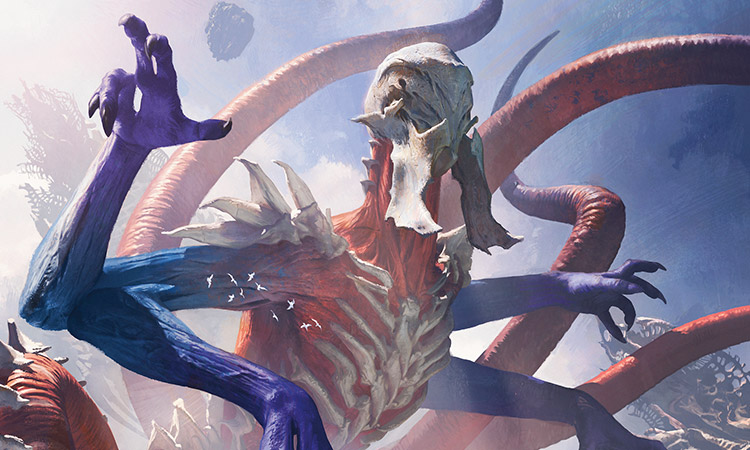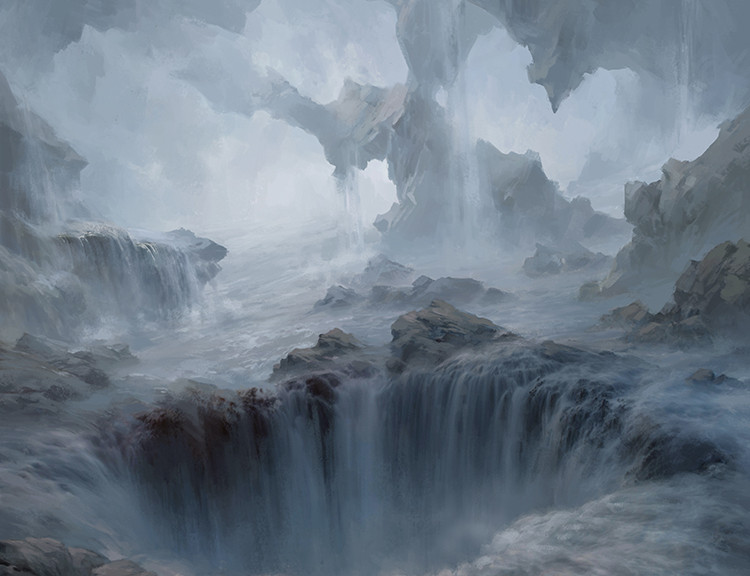By: James Chillcott (@MTGCritic)
This weekend most of you are already in the pocket on pre-release hype and debates surrounding Battle for Zendikar. The initial response to the new set has been tepid to say the least, and many players are debating whether this is a set they want to invest in given the heavy reliance on the Expedition lands to hold up the sets’ EV (Expected Value).
Meanwhile, in the background, our final core set ever is quietly setting up to possibly become the most desirable sealed product in recent memory.
Take it from someone with a lot of sealed product in the closet: sealed is not really where you want to be. For every SDCC set or Modern Masters booster box I’ve made money on, I’ve got a couple of FTV: 20 sets or boxes of Return to Ravnica just hanging out waiting on an increase. Overall, sealed can only be expected to appreciate 5-10% per annum, with Fat Packs and select foreign booster boxes being your best bets for better results.
That being said, every few years or so a set beats expectations, usually on the back of some very good cards that show up in deck after deck in multiple formats. (You can read about my recent survey of Booster Boxes vs Fat Packs over here.)
Sets that have settled at over $200 per box since 2009, include all of the following (with approximate prices and annual returns as of May/15):
- Innistrad: $225 (40%/yr)
- New Phyrexia: $350 (70%/yr)
- Scar of Mirrodin: $200 (26%/yr)
- Rise of the Eldrazi: $600 (110%/yr)
- Worldwake: $700 (115%/yr)
- Zendikar: $550 (85%/yr)
So what do these figures tell us? Well, for one, they suggest that holding boxes of good sets heading into the last major player population explosion in Magic (2010-2013) and the advent of Modern as a dominant new format was a pretty sweet deal. It also highlights that holding core sets was almost never a good idea, with most 4-6 year old core sets still languishing below $150 with the rest of the dregs. It’s also worth noting that since 2011, only Innistrad has been worth stashing away extra boxes of, and even then, they haven’t been super liquid according to the peers I’ve spoken to.
We should also have a look at what factors made the above boxes so valuable. One of the strongest predictors of when a booster box will beat the odds seems to be how many of its’ cards make it into the Top 200 Modern/Legacy playables list as format staples.
Let’s take a look at the sets since 2009 and how many staples they can boast, placed alongside Magic: Origins:
| Origins | Innistrad | New Phyrexia | SOM | ROE | Worldwake | Zendikar |
Jace, Vrynn's Prodigy
| Liliana of the Veil | Karn Liberated | Mox Opal | Emrakul, the Aeons Torn | Jace, the Mind Sculptor | Scalding Tarn |
| Hangarback Walker | Snapcaster Mage | Spellskite | Wurmcoil Engine | Linvala, Keeper of Silence | Stoneforge Mystic
| Misty Rainforest |
| Liliana, Heretical Healer | Geist of Saint Traft | Batterskull | Blackcleave Cliffs | Vengevine
| Creeping Tar Pit | Verdant Catacombs |
| Abbot of Keral Keep | Olivia Voldaren | Elesh Norn, Grand Cenobite | Darkslick Shores | Splinter Twin | Celestial Collonade
| Arid Mesa |
| Day's Undoing | Sulfur Falls | Gitaxian Probe | | Inquisition of Kozilek | Raging Ravine | Marsh Flats |
| Goblin Piledriver | Stony Silence | | | | Amulet of Vigor | Goblin Guide |
| Evolutionary Leap | Gavony Township | | | | Stirring Wildwood | Iona, Shield of Emeria |
| Harbinger of the Tides | | | | | Death's Shadow | Pyromancer's Ascension |
| Dark Petition | | | | | | Valakut, the Molten Pinnacle |
| | | | | | Spell Pierce |
This table demonstrates that Magic: Origins holds more staples and potential Modern/Legacy staples than almost any high value set other than Zendikar, Worldwake and Innistrad, all sets that must be considered the pinnacle of modern set valuations. Of the cards listed as notable in Origins for the purposes of increasing box value, Jace, Walker, Abbot, Day’s Undoing, Harbinger of Tides and Dark Petition have all already seen relevant play in Modern, Legacy and/or Vintage. Liliana, Piledriver, and Evolutionary Leap still need to find homes, but their power levels are such that I feel confidant that at least two of the three will get there within the next few years as relevant partner cards are printed to drive them.
Clearly, I’m not the only one who sees long term value in Magic: Origins either. Just take a look at the foil premiums (with 2x being average for most cards) being commanded by the cards on my list:
| Card Name | Reg Price | Foil Price | Multiplier |
| Jace, Vrynn's Prodigy | $45 | $90 | 2.0 |
| Hangarback Walker | $18 | $40 | 2.2 |
| Liliana, Heretical Healer | $17 | $45 | 2.6 |
| Abbot of Keral Keep | $7 | $24 | 3.4 |
| Day's Undoing | $5 | $27 | 5.4 |
| Goblin Piledriver | $4 | $13 | 3.3 |
| Evolutionary Leap | $3 | $10 | 3.3 |
| Harbinger of the Tides | $2 | $10 | 5.0 |
| Dark Petition | $1 | $7 | 7.0 |
Let’s take a deeper look at each of the cards that are mostly likely to drive value for Magic: Origins.
-

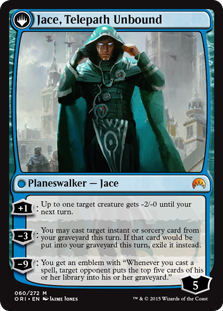
- Regular Price: $45
- Foil Price (Multiplier): $90 (2x)
In my Magic: Origins, Digging for Dollars article, I dismissed the youngest Jace as an overpriced card that needed to find a deck in a hurry to hold its price, but boy did it prove its value! Apparently, a Merfolk Looter with upside that offers sweet synergies with fetch lands, sorcery-speed spells, and graveyard creature recursion is good enough all the way back to Legacy.
Remember, this is an iconic, mythic planeswalker from a summer set with limited sales, often played as a two- to four-of, viable in Standard, Modern, Legacy, and EDH/casual. The non-foils are going for $45+ or so on strong Standard play, and foils have recently spiked from $45 to nearly $90, which still represents just a 2x multiplier. Shortly before it spiked, I called foil Jace to hit $80 to $100 within the year and here we are. I also called it the next foil Liliana of the Veil, a card that still commands about $230 despite the printing of a Pro Tour promo version last year. If Jace finds a permanent home in Modern and Legacy by the time Origins goes out of print, the odds of boxes gaining faster than normal could skyrocket on the back of a potential $150-200 mythic foil.

- Regular Price: $18
- Foil Price (Multiplier): $40 (2.2x)
Here’s another tier-one card that almost everyone missed on the first pass. Hangarback has already demonstrated value as a multi-copy slot in a variety of Standard decks from UR Artifacts to Abzan to Jeskai and is likely to be a staple heading into the fall metagame. More importantly, it showed up in top decks all the way back to Vintage at Eternal Weekend several weeks back, having been featured on camera in an innovative Shops/Robots deck. Sam Black was rocking it this week as part of a Jeskai Trinket Mage deck in Modern. (Not that you care, but I’m also testing it with Bitterblossom, Lingering Souls, Evolutionary Leap, and Siege Rhino in Modern, and I suspect it will find at least a few homes in Modern within the year.)
As a colorless creature with a flexible mana cost, resiliancy to non-exiling kill spells, synergy with +1/+1 counters, artifacts, sacrifice effects, and creature buffs, Hangarback Walker now looks like the very definition of a card set up to be a long-term multi-format staple. And as a rare from a Magic Origins, a low-supply summer set, chances are good that foils can beat average returns and grow in a big way as more and more decks are uncovered that want to use it. Also in it’s favor is the fact that, like Snapcaster Mage, the card is powerful without being utterly broken, making deflation through banning(s) a low-risk scenario. There are very few foil Hangarback Walkers left available online at $30, and supply is dwindling. I fully expect this card (in foil) to hit $50 to $60 within the year.
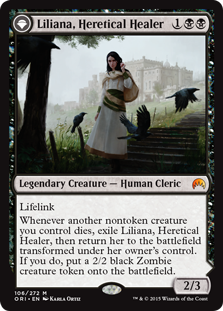
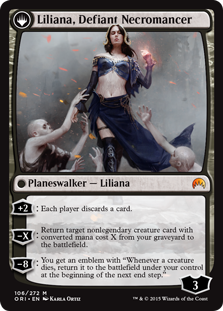
- Regular Price: $17
- Foil Price (Multiplier): $45 (2.6x)
Liliana, Heretical Healer was originally though by many to be the strongest of the Origins planeswalkers, but despite the early hype, hasn’t really found a home in Standard, let alone Modern. For her to hold long term value she will need to find a Modern home in something grindy that leverages Collected Company or some other creature engine to immediately flip her for full value. The card isn’t powerful enough to see play in Legacy or Vintage, but the option to run this as an EDH general may prop up the foil multiplier. For now I consider this a long shot to add value to the set overall, but I’m certainly doing my best to make it work in a few different Aristocrats style decks.

- Regular Price: $7
- Foil Price (Multiplier): $24 (3.4x)
Here we have another underestimated card, now headed straight to stardom. Patrick Chapin has been championing the card as a 4-of auto-include in both Temur Prowess and Grixis Control in Modern, and in any deck where the casting cost is low enough to take advantage, the ability to nab an extra card once with Abbot and again with Snapcaster Mage is looking tempting indeed. Abbot of Keral Keep has also been doing reasonably well as a Red Deck Wins staple in Standard, but it’s the Modern play that has pushed its’ foil up to the $24 price point it currently occupies, just a month after I was telling everyone to nab them near $10.
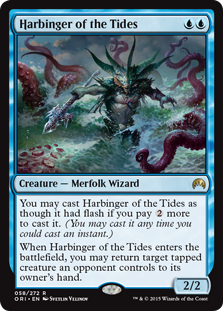
- Regular Price: $2
- Foil Price (Multiplier): $10 (5.0x)
This is a four-of in Modern Merfolk, a deck that recently won a Modern GP. As yet another Magic Origins rare that will see Modern play and has some degree of casual appeal, this has a decent shot of doubling up within the next couple of years so long as Merfolk stays viable as a Tier 1 deck. At $2, regular copies are almost impossible to go wrong with right now as the water tribe has plenty of casual appeal as well.
6.Day’s Undoing

- Regular Price: $4
- Foil Price (Multiplier): $27 (5.4x)
So here we have a “fixed” version of the Power 9 stalwart Timetwister. The fix supposedly resides in the fact that you don’t get to do anything with this the turn it goes off, putting your opponent squarely in the driver’s seat. For it to be broken, it needs to find a home in either a) a deck so aggressive it could care less about blowing a turn to fill up it’s hand or b) a combo deck that intends to ignore whatever the opponent does with all their extra cards. Due to the low casting cost I have some faith that this card will get there, but so far, despite rumblings about use in Modern Affinity decks, the foil multiplier seems to be running well ahead of performance. That being said if this one ever goes off, it can only help the cause for Origins.
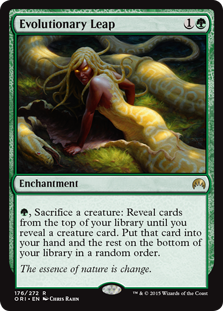
- Regular Price: $3
- Foil Price (Multiplier): $10 (3.3x)
Evolutionary Leap is one of the more unproven picks on this list, but I see a card whose true potential is still under the radar. The low casting cost, easy splash-ability, and the ability to contribute to both combo and grindy value strategies seems to balance well against its lack of immediate board impact. At the GP Charlotte Modern tournament last month, Chris VanMeter started off 6-0 with his G/B Elves combo deck before fading from contention. The deck was running four copies of Leap and amply demonstrated the ability for this card to lead to big plays. (As I mentioned above, I’m currently testing the card as a way to trade tokens for reliably powerful creatures like Siege Rhino in Modern, but I have confidence that a better player will find even more exciting reasons to be running this subtle enchantment as new partner cards appear on the horizon. At present copies are available online around $10 or $11, so the entry point on foils is attractive if you agree that this is a future pillar in at least one good Modern or Legacy deck. I’m targeting a six to eighteen month window for foils to top $20 (longer than the last time I discussed it).
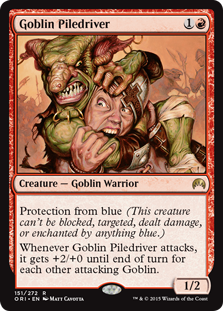
- Regular Price: $4
- Foil Price (Multiplier): $13 (3.3x)
If you’ve never been on the other end of a beating from this gibbering red weapon, let me set your head straight. Goblins are one of the most printed tribes in the history of the game and sooner or later a Goblins deck will break back into Tier 1 status in Modern and the price of this card ablaze. It can’t be hit by Electrolyze or blocked by Snapcaster Mage and it can do seven damage out of nowhere. Prior to the reprint the card was holding a higher price tier, so don’t be surprised when it slides back up while you aren’t looking.
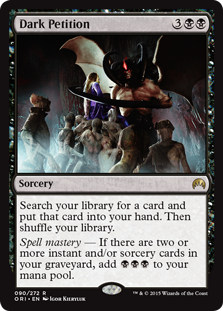
- Regular Price: $1
- Foil Price (Multiplier): $7 (7.0x)
Never underestimate a card that can be cast as Dark Ritual and Demonic Tutor (both broken) at the same time, in any deck that can afford to cast it. Already ANT, Storm and Battle of Wits decks are putting the card to use, and it won’t be that long before it wins something big and jumps. $1 for regular copies is simply scandalous and even $7 foils are a joke if the play pattern expands. I’d get in on some of these now as a long shot spec.
Tempering Expectations
So will Magic: Origins booster boxes, currently available for around $88, end up over $400 by 2018? In short, I doubt it. Despite the plethora of playable Modern and Eternal cards in the set, and the lower print run as a summer core set it would be tough to reach such heights. I am however targeting $200 in the same timeframe, and perhaps $80+ on Fat Packs.
The reality is that a big part of the gains on the 2009-2011 sets probably came from the confluence of impacts from player growth in the early part of the decade and the advent of Modern as a new format that suddenly demanded cards from the older sets.
It’s very telling that no set since Innistrad is worth more than $150 by the box, as it’s a strong sign that real supply has outpaced demand for the last few years. The shortening of the Standard play cycle from 24 months to 18 months may also represent that WoTC is trying to squeeze more money out of the existing players in the face of weakening player growth, which is not a great environment for sealed growth. All of this could create some very real drag against the set.
That being said, Magic: Origins has at least twice as many long term rare or mythic playables vs. sets like Theros and Return to Ravnica, and the foil multipliers are already running well ahead of the averages. With so many great cards in a summer set that’s still being underestimated, if you’re considering a box of Battle for Zendikar this week, you may want to consider stashing away some cheap boxes or Fat Packs of Origins instead. If you can get your hands on Russian, Korean or Japanese boxes at good prices instead, all the better to leverage the future value of insane foil multipliers. Either way, I’m willing to bet that Origins beats BFZ down the road.
(Full disclosure: I am holding copies of at least some of the cards on this list. I am not in on booster boxes yet, but intend to be before the end of the year.)
James Chillcott is the CEO of ShelfLife.net, The Future of Collecting, Senior Partner at Advoca, a designer, adventurer, toy fanatic and an avid Magic player and collector since 1994.
ADVERTISEMENT: Get the Cube Starter Bundle with the 3rd Edition Grimoire Deck Box, the brand new Grimoire Deck Box designed specifically for the red mage in you.



